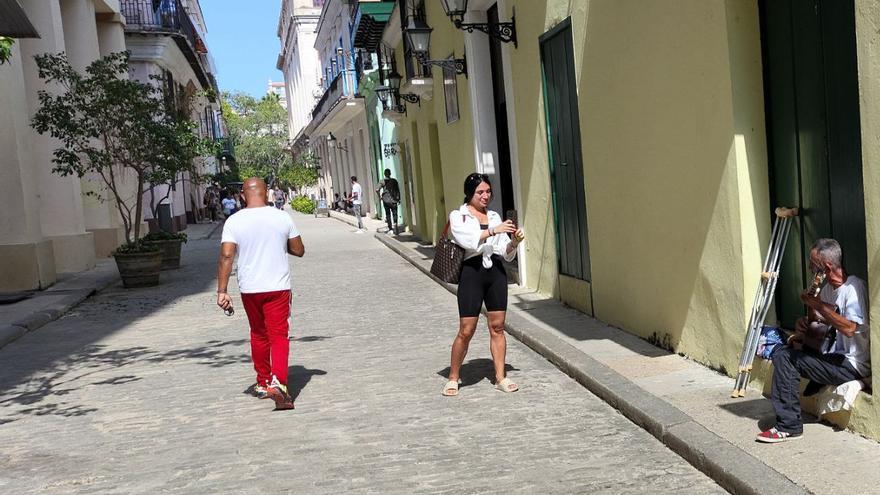
![]() 14ymedio, Juan Diego Rodríguez, Havana, 10 November 2023 — The sullen face, the revolver in his belt and a straw sombrero converted into a tricorn hat: the living statue of the pirate on Calle de los Oficios does not need to set up an ambush to fill his chest. The one dollar bill that he carries in the lid of his piggy bank, like a talisman, says it all: the secret to getting the buccaneer to move – like everything in Havana – is money.
14ymedio, Juan Diego Rodríguez, Havana, 10 November 2023 — The sullen face, the revolver in his belt and a straw sombrero converted into a tricorn hat: the living statue of the pirate on Calle de los Oficios does not need to set up an ambush to fill his chest. The one dollar bill that he carries in the lid of his piggy bank, like a talisman, says it all: the secret to getting the buccaneer to move – like everything in Havana – is money.
Not even the copper makeup can hide his displeasure when a naive person drops Cuban pesos into the chest. Based among the old Havana cannons, the pirate barely changes his position. “Don’t even think of saying anything else to Jack Sparrow,” one observer sarcastically comments, alluding to the bandit in the film Pirates of the Caribbean. “What he wants is green.”
The buccaneer, who tries to make a living under the tropical sun, is another sign that Old Havana has seen better times. Like the so-called “heritage stores” – which sold any souvenir at a very high price to tourists – or the Obispo bookstores, street art was one of the projects with which the Office of the Historian aspired to breathe life into the historic center and, thus, fill its own coffers.
Now, however, Eusebio Leal himself has ended up becoming a statue – and not a living one – while the Office, without a historian and under the control of the Government, has been unable to sustain its cultural and financial projects in the city center. This is attested to by the scarcity, if not the total dismantling, of the initiatives that depended on Leal’s skill and personal contacts.

A solid fence prevents walkers from entering the small Oficios park, on the corner of Sol. Leaves, garbage and poorly maintained plants are what can be seen between the bars of what was once a recreational space for Havana residents. Years ago, an artificial stream ran through its canals that filled several fountains, and the elderly people of the area sat on its benches to sunbathe.
A herd of tourists, who do not pay much attention to the ruins, wander through the Havana port, cross the Plaza de Armas and go up Obispo in search of the bookstores indicated on the map on their phones. Total disappointment: La Moderna Poesía, which was once the most famous bookstore in Cuba – the young Lezama Lima held his gatherings there – is now in the most regrettable abandonment.
Only in the Fayad Jamís, whose wooden façade has not been varnished for years, are there books, but few are Cuban. Most of them are Venezuelan titles that are of little interest to the reader, and some of Leal’s books translated into English and French, which are sold as a kind of sentimental tourist guides to Havana.
There is not much to expect from the “heritage stores” either. The once formidable Havana branch of Cuervo y Sobrinos – the Cuban watchmaker founded in 1862 and nationalized by Fidel Castro – which managed to resurrect its prestige thanks to Swiss investors, has now withdrawn its luxury watches from the capital. Instead, they sell straps and bracelets.

Completing the panorama of the high tourist season are numerous beggars and other “hunger artists” who, guitar in hand, try to extract a few dollars from the visitor who observes them. When a Canadian or an Italian arrives there is luck, but if he plays to a Russian, not even singing to him in his language – as the troubadour-beggar does in Obispo – he might manage to get a ruble.
With that thunder, on the island of pirates and ruins the only thing left to do is sneak over to the Plaza Vieja and look on the map for a bar where you can quench your thirst. The visitor’s final disappointment awaits him there: there is no beer even in the Casa de la Cerveza. “Havana is closed!” they shout at him, without him knowing very well where the voice is coming from.
____________
COLLABORATE WITH OUR WORK: The 14ymedio team is committed to practicing serious journalism that reflects Cuba’s reality in all its depth. Thank you for joining us on this long journey. We invite you to continue supporting us by becoming a member of 14ymedio now. Together we can continue transforming journalism in Cuba.
